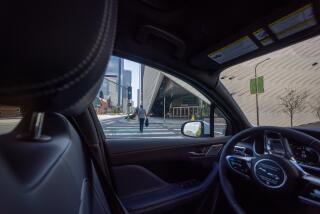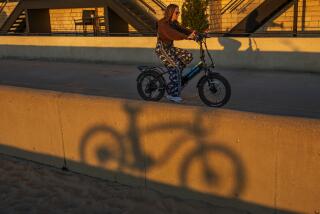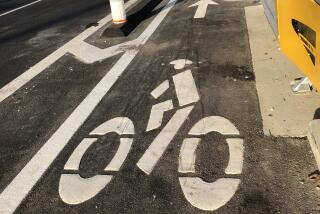TRANSPORTATION : Fear of 4-Wheel Commuters Keeps Bike Kickstands Down
- Share via
WASHINGTON — Next time you go for a bicycle ride, you might consider this: More than 100 million Americans did the same thing last year, but fewer than one in 25 pedaled to work even once--even though, for half of the nation’s workers, the ride would be less than five miles.
Why didn’t more bikers ride to work? The answer is one of many found in the “National Bicycling and Walking Study” just released by the Transportation Department.
The $1-million study, prepared for Congress, attempts to discover why Americans do not walk or bike more in general, what those choices mean for health and the environment and how people can be encouraged to go from here to there by using their feet for something other than gas pedals.
Not surprisingly, the study found that bicycling and walking would make Americans healthier, cut traffic jams and reduce pollution.
“It also will lead to healthier, more active lifestyles, an important component of the President’s health care initiative,” Transportation Secretary Federico Pena told a rally of bicyclists held here in conjunction with release of the report.
Americans should double the trips they take by bike or foot, which would have people leave the car at home about 16% of the time, the study said.
So why didn’t more people bike or walk to work? According to the study, the primary reason is concern for their safety.
Although in recent decades a large number of U.S. cities have built networks of walkways and bike lanes, many were designed for recreational purposes--not to move large numbers of walkers or bikers along major commuting routes. Perhaps more important, many communities still have no separate lanes or paths of any kind for bicyclists.
“We really don’t do a good job in most of our cities in accommodating bicycles,” said Barbara McMillen of the Transportation Department’s Federal Highways Bicycle Program Office.
Without the benefit of special routes, cyclists and walkers are forced into the chancy practice of mingling with rush-hour traffic. Accident statistics make the point vividly. Car accidents involving bicycles or pedestrians killed more than 6,000 people last year and injured 75,000, the study said.
A recent Harris poll showed that nearly half of adult bicyclists said they would pedal to work at least occasionally if they were provided with safe places to ride.
To encourage more people to leave their cars at home, government needs to provide for bicyclists and pedestrians in local, state and federal transportation plans--building bike lanes alongside new roadways, adding them to existing routes and creating sidewalks where needed.
Transportation Department officials said bicycle plans must be included in the long-range transportation plans that every state and metropolitan area is to submit within the next eight months under terms of the Intermodal Surface Transportation Efficiency Act approved by Congress in 1991.
Local authorities can help further, the report said, by considering biking and walking routes in land use and law enforcement decisions, which could include:
* Requiring bikeways and walkways in new housing developments.
* Discouraging suburban sprawl--which often leapfrogs beyond the urban fringe and puts housing a long distance from jobs and stores--while encouraging more mixed-use neighborhoods in which housing, shopping and work are within biking or walking distance.
* Creating police bike patrols to enhance safety through enforcement of bicycle and pedestrian laws.
Local officials also can reach out to invite citizens to play a role in planning. “If you work with these people and let them know that they have a say in what the community will be like, then they will participate more,” McMillen said.
William Wilkinson, executive director of the Bicycle Federation of America, called on bikers to pressure government representatives at all levels to adopt measures to improve commuter routes.
More to Read
Sign up for Essential California
The most important California stories and recommendations in your inbox every morning.
You may occasionally receive promotional content from the Los Angeles Times.













